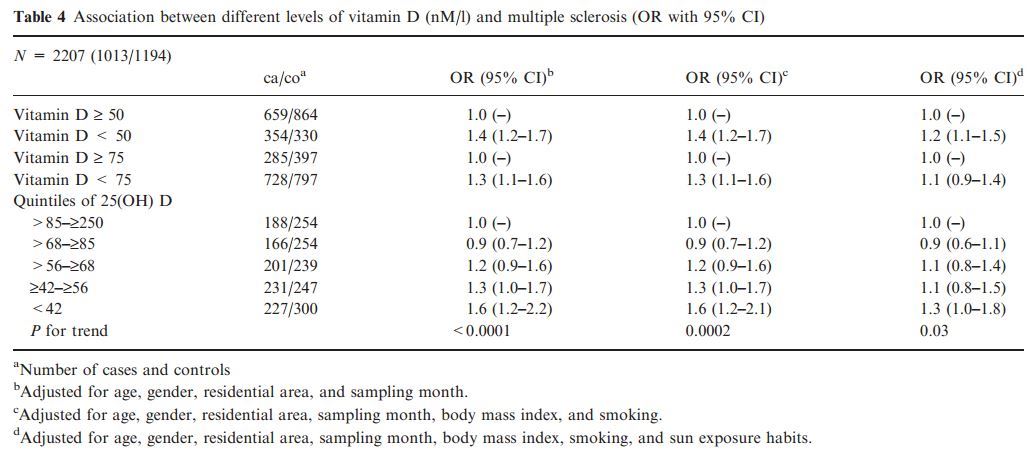MS prevention by UV is 2X better than prevention by vitamin D levels
Sunlight is associated with decreased multiple sclerosis risk: no interaction with human leukocyte antigen-DRB1*15.
Eur J Neurol. 2012 Jan 31. doi: 10.1111/j.1468-1331.2011.03650.x.
Bäärnhielm M, Hedström AK, Kockum I, Sundqvist E, Gustafsson SA, Hillert J, Olsson T, Alfredsson L.
Institute of Environmental Medicine, Karolinska Institutet, Stockholm Department of Clinical Neuroscience and Center for Molecular Medicine, Karolinska Institutet at Karolinska University Hospital, Stockholm Department of Molecular Medicine and Surgery, Karolinska Institutet at Karolinska University Hospital, Stockholm, Sweden.
Background:? Both insufficient exposure to sunlight and vitamin D deficiency have been associated with an increased risk for multiple sclerosis (MS). An interaction between human leukocyte antigen HLA-DRB115 and vitamin D in MS was recently proposed. We investigated the association between previous exposure to ultraviolet radiation (UVR), vitamin D status at inclusion in the study, and MS risk including the interaction of these factors with HLA-DRB115.
Methods:? A population-based case-control study involving 1013 incident cases of MS and 1194 controls was performed in Sweden during 2005-2010. Subjects were classified according to their UVR exposure habits , vitamin D status, and HLA genotypes. The associations between different sun exposure habits/vitamin D levels and MS were calculated as odds ratios (OR) with 95% confidence intervals (CI) using logistic regression. Potential interaction was evaluated by calculating the attributable proportion due to interaction.
Results:? Subjects with low UVR exposure had a significantly increased risk of MS compared with those who reported the highest exposure ( OR 2.2 , 95% CI 1.5-3.3).
Similarly, subjects who had 25-hydroxy-vitamin D levels less than 50 nM/l had an increased risk for MS ( OR 1.4 , 95% CI 1.2-1.7). The association between UVR exposure and MS risk persisted after adjustment for vitamin D status. There was no interaction with HLA-DRB1*15 carriage.
Conclusions:? UVR and vitamin D seem to affect MS risk in adults independently of HLA-DRB1*15 status. UVR exposure may also exert a protective effect against developing MS via other pathways than those involving vitamin D.
1.4X more likely to get MS if had low vitamin D

PDF is available free at Sci-Hub 10.1111/j.1468-1331.2011.03650.x
See also VitaminDWiki
Less intestinal cancer in mice if add vitamin D, but even less with ultraviolet light – June 2014
Topical Vitamin D provides more benefits than oral sometimes - many studies
- Topical includes UV
Overview MS and Vitamin D which has the following
- Controversy: Which is better: UV or Vitamin D
- Increased sun and vitamin D both reduced MS risk – March 2011
- 30% less likely to get MS for UV increase of 1000 kJ/m2
- dissertation UV and MS - 2010.PDF file
- 7% less likely to get MS for each 4 ng increase in vitamin D level in blood
Multiple Sclerosis – many reasons to believe Vitamin D can prevent and treat it – Feb 2018
The articles in both MS and UV categories are:
{category}
Vitamin D Binding Protein category listing has items and the following introduction
{include}
